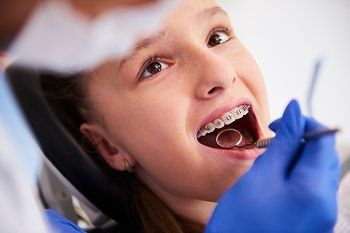Basics of Tooth Movement and How Orthodontics Works
In this blog, we will take you through the fundamental concepts of tooth movement and delve into the mechanisms behind orthodontic treatment. Whether you are considering orthodontic treatment for yourself or simply curious about how it all works, this guide will help you understand the principles and processes involved.
Defining Tooth Movement and the Importance of Proper Tooth Alignment
Tooth movement refers to the controlled shifting of teeth within the oral cavity to achieve a desired arrangement. It involves applying gentle force to the teeth, gradually influencing their position and alignment. These forces encourage the remodeling of the supporting structures, including the periodontal ligament and the alveolar bone, facilitating the desired movement.
Proper tooth alignment plays a vital role in oral health and overall well-being. When teeth are well-aligned, several benefits arise. First and foremost, a well-aligned bite promotes effective chewing, allowing for efficient food breakdown and digestion. It also facilitates proper speech, enabling clear pronunciation and communication.
Moreover, proper tooth alignment contributes to improved oral hygiene. When teeth are aligned correctly, it becomes easier to brush and floss effectively, reducing the risk of dental issues such as tooth decay and gum disease. Additionally, well-aligned teeth distribute the forces of chewing evenly, minimizing the likelihood of excessive wear, fractures, or temporomandibular joint disorders.
Beyond the functional aspects, the aesthetic value of a straight, attractive smile should be considered. Well-aligned teeth can boost self-confidence, enhance facial aesthetics, and positively impact social interactions and self-image.
Orthodontics, with its diverse treatment options and skilled professionals known as orthodontists, specializes in harnessing the power of tooth movement to achieve these desirable outcomes. By utilizing various appliances, such as braces or clear aligners, orthodontists carefully manipulate the forces acting on the teeth to guide them into their optimal positions.

Common orthodontic issues
Orthodontic issues can affect people of all ages, and addressing these concerns is at the core of orthodontic treatment.
Crowding
Crowding is a prevalent orthodontic issue, with insufficient space within the dental arch to accommodate all teeth adequately. As a result, the teeth may overlap, twist, or appear misaligned. Crowding can occur due to various factors, including genetics, inadequate jaw growth, early loss of primary teeth, or improper eruption of permanent teeth. It affects the smile's appearance and can also impact oral hygiene, making it challenging to clean crowded areas effectively.
Spacing
Spacing refers to gaps or spaces between teeth that exceed the normal range. This condition can occur due to several factors, such as small-sized teeth, missing teeth, or abnormal jaw growth patterns. Spacing can lead to self-consciousness about one's smile and may also contribute to proper chewing and speech difficulties.
Malocclusions
Malocclusions, or improper bites, encompass various misalignment issues that affect how the upper and lower teeth fit together. Some common types of malocclusions include:
- Overbite
- Underbite
- Crossbite
- Open bite
Understanding Orthodontic Principles, Forces, and Appliances
Orthodontic Principles and Biomechanics
Orthodontic treatment is based on established principles and biomechanical concepts that govern the movement and alignment of teeth. These principles consider force application, bone remodeling, and tissue response. Orthodontists analyze each patient's unique case to create personalized treatment plans that optimize the application of these principles.
Biomechanics, the study of forces and their effects on living organisms, plays a central role in orthodontics. By understanding teeth' biomechanical properties and surrounding structures, orthodontists can apply appropriate forces to achieve desired tooth movements effectively and safely.
Forces Applied to Teeth During Treatment
Orthodontic treatment involves the application of controlled forces to induce tooth movement. These forces exert pressure on the teeth, stimulating bone remodeling and allowing for gradual repositioning. Orthodontists calculate the forces' amount, direction, and timing to achieve the desired tooth alignment.
Common forces applied during orthodontic treatment include:
- Tipping: Involves applying forces to the crown of a tooth to change its inclination or angle.
- Torque: Refers to the rotation of a tooth around its long axis, adjusting its angulation within the dental arch.
- Intrusion/Extrusion: These forces move a tooth vertically, pushing it deeper into the socket or guiding it to protrude further.
- Bodily movement: Involves applying forces to move the entire tooth, including the root, within the bone, ensuring proper alignment and occlusion.
Orthodontic forces can be applied through various orthodontic appliances, such as braces, clear aligners, or other specialized devices. These appliances work in conjunction with the principles of biomechanics to generate specific forces that guide tooth movement over time.
Role of Brackets, Wires, and Other Appliances
Brackets, wires, and other appliances form the foundation of orthodontic treatment. Brackets are small attachments bonded to the teeth, acting as anchors for the archwire. The archwire connects the brackets and applies forces to the teeth, directing their movement. Orthodontists carefully select and adjust the archwire's size, shape, and material to achieve optimal tooth alignment.
Additionally, orthodontic appliances, such as elastics, springs, or aligners, may be used with braces to enhance tooth movement and address specific orthodontic issues. These appliances provide additional forces and support to guide teeth into their desired positions.
Phases of Orthodontic Treatment: Consultation, Active Treatment, and Retention
Orthodontic treatment is a carefully planned process involving distinct phases to achieve optimal tooth alignment and bite correction. Understanding these phases can provide valuable insights into the progression of orthodontic treatment and the importance of each stage. In this section, we will explore the three primary steps of orthodontic treatment:
- The initial consultation and evaluation
- The active treatment phase
- The retention phase and post-treatment care
Initial Consultation and Evaluation
The journey toward a beautifully aligned smile begins with an initial consultation with an orthodontist. During this visit, the orthodontist thoroughly evaluates the patient's dental and facial structure, which may involve X-rays, photographs, and impressions. The orthodontist assesses the existing orthodontic issues, evaluates the patient's oral health, and discusses the patient's concerns and treatment goals.
Based on this evaluation, the orthodontist formulates a personalized treatment plan, outlining the recommended orthodontic appliances, estimated treatment duration, and expected outcomes. The initial consultation allows the patient to ask questions, understand the proposed treatment, and make an informed decision regarding their orthodontic journey.
Active Treatment Phase
The active treatment phase is the core of orthodontic treatment, during which the prescribed orthodontic appliances are utilized to guide the teeth into their desired positions. The specific treatment approach depends on the patient's unique needs, treatment plan, and the orthodontist's expertise.
Orthodontic appliances, such as braces or clear aligners, apply controlled forces to the teeth to gradually move them into alignment. Regular check-up appointments are scheduled throughout this phase to monitor progress, make necessary appliance adjustments, and ensure that the teeth move according to the treatment plan. Patients are encouraged to maintain good oral hygiene practices, follow dietary guidelines, and adhere to any specific instructions provided by the orthodontist.
Retention Phase and Post-Treatment Care
Upon completion of the active treatment phase, the retention phase begins. This phase is crucial to maintain the achieved results and prevent any relapse or shifting of the teeth. The orthodontist will prescribe a retention protocol, which may include using retainers or other devices to stabilize the teeth in their new positions.
Regular follow-up appointments are scheduled during the retention phase to assess the stability of the teeth and monitor any changes. The orthodontist will guide the duration and usage of retainers, proper oral hygiene practices, and maintenance of the orthodontic appliances.

Potential Discomfort and Side Effects
During orthodontic treatment, it is common to experience some soreness in the teeth and gums. This soreness is a normal response to the forces exerted on the teeth as they move. The soreness may vary from person to person and can be managed with over-the-counter pain relievers or by rinsing with warm saltwater.
Additionally, tooth sensitivity may be experienced, especially when consuming hot or cold foods and beverages. This temporary sensitivity should diminish as the teeth adjust and become appropriately aligned. Using toothpaste specifically designed for sensitive teeth can help alleviate discomfort.
By maintaining proper oral hygiene practices, patients can minimize the risk of tooth decay, gum inflammation, and other potential side effects associated with orthodontic treatment.
Duration and Cost of Orthodontic Treatment
Orthodontic treatment is an investment in achieving a healthy, beautiful smile. It's essential to clearly understand the treatment timeline and financial considerations associated with orthodontic care. In this section, we will explore the duration of orthodontic treatment, factors that can affect treatment duration, and the financial aspects of orthodontic care, including cost and insurance coverage.
- Treatment Timeline
The duration of orthodontic treatment varies depending on individual factors, such as the complexity of the orthodontic issues, the type of treatment, and the patient's response to treatment. Orthodontic treatment can last from several months to a few years.
During the initial consultation, the orthodontist will provide an estimated treatment timeline based on the specific treatment plan and individual circumstances. It's important to note that this estimate may be subject to adjustments based on the treatment progress and the patient's cooperation in following the orthodontist's instructions.
Regular check-up appointments are scheduled throughout the treatment to monitor progress, make necessary adjustments, and ensure the treatment is on track. Open communication between the patient and the orthodontist is crucial to address concerns and clearly understand the treatment timeline.
- Factors Affecting Treatment Duration
Several factors can influence the duration of orthodontic treatment, including:
- The severity of orthodontic issues: The complexity of the problems being addressed can impact the treatment duration. More severe cases may require longer treatment times to achieve desired results.
- Age and growth: The patient's age and growth potential can affect treatment duration. In some cases, orthodontic treatment may be more efficient during certain stages of growth and development.
- Patient compliance: Following the orthodontist's instructions, such as wearing aligners or elastics as prescribed and maintaining good oral hygiene, is crucial for timely treatment completion. Lack of compliance can prolong the treatment duration.
- Type of treatment: The chosen orthodontic treatment approach can impact the duration. Some treatments, such as clear aligners, may offer shorter treatment times for some instances compared to traditional braces.
Discussing these factors with the orthodontist during the initial consultation is essential to better understand the expected treatment duration for individual cases.
Financial Considerations and Insurance Coverage
The cost of orthodontic treatment varies based on factors such as the type of treatment, the complexity of the case, and the geographic location. Orthodontic treatment is an investment, and it's essential to consider the financial aspects.
During the initial consultation, the orthodontist's office can provide a detailed breakdown of the treatment cost, including consultation fees, X-rays, appliances, adjustments, and retainers. Many orthodontic practices offer flexible payment plans to help manage the cost of treatment, allowing for monthly installments.
Contact your Danville dentist, Dr. Hoss Abar, DDS, MSD, at Danville Orthodontics to learn more about the Basics of Tooth Movement and How Orthodontics Works.
Resource:
How do orthodontic treatments work?
*Neither this nor any other content in this media is meant to prescribe, recommend, or prevent any treatment or procedure. We highly recommend that you get the advice of a qualified dentist or other medical practitioners regarding your specific dental condition.
